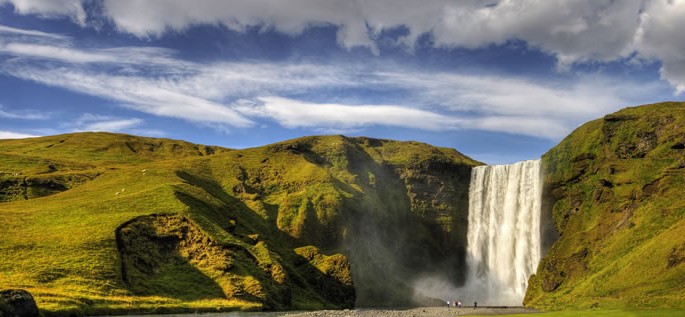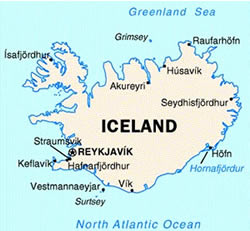
Icelandic
Icelandic (Islenska) belongs to the Northern group of the Germanic branch of the Indo-European language family. It is spoken mostly in Iceland, and its closest relative is another insular language, Faroese, although the two languages are not mutually intelligible because they have developed in isolation from each other.

Status
Icelandic is the de facto national language of Iceland where it is spoken by all of Iceland’s 319,000 citizens. Icelandic is the medium of education, although some education is available in other languages. It is the language of government, business and the media. There are a number of Icelandic newspapers, magazines and radio stations in addition to several TV channels. There are also speakers of Icelandic in the U.S., Canada, and Denmark (Ethnologue).
Dialects
Icelandic does not have any notable dialect differences due to the fact that it is spoken on one isolated island.
Structure
Sound system
The sound system of Icelandic is typical of all Germanic languages.
Vowels
Icelandic has nine vowel phonemes, i.e., sounds that make a difference in word meaning. They are given below. Stressed vowels are long in monosyllabic words where the vowel is word-final, before single consonants, and before consonant clusters /pr, tr, kr, sr, pj, tj, sj, tv, kv/. Unstressed vowels are always short. In addition, Icelandic has 5 diphthongs: /ei, œi, ai, au, ou/.
|
Unrounded
|
Rounded
|
Unrounded
|
Rounded
|
|
| Close |
i
|
y
|
u
|
|
| Near-close |
I
|
ʏ
|
||
| Open-mid |
ɛ
|
œ
|
ɔ
|
|
| Open |
a
|
|||
- Rounded vowels are pronounced with rounded and protruding lips.
- /i/ = ee in beet
- /i/ = i in bit
- /ɛ/ = e in bed
- /y, ʏ, œ/ have no equivalents in English.
- /u/ = oo in boot
- /ɔ/ = vowel in bought
Consonants
Icelandic has 21 consonants. Many consonants can be either short or long. Consonant length makes a difference in word meaning
| Stops |
plain
|
p
|
t
|
c
|
k
|
|||
|
pʱ
|
tʱ
|
cʱ
|
kʱ
|
?
|
||||
| Fricatives |
f
|
θ
|
s
|
ç.
|
x
|
|||
| voiced |
v
|
ð
|
ɣ
|
|||||
| Nasals |
m
|
n
|
ɲ
|
ŋ
|
||||
| Lateral fricative |
ɬ
|
|||||||
| Lateral approximant |
l
|
|||||||
| Trill |
r
|
|||||||
| Semivowel |
j
|
- There is a contrast between aspirated /pʱ, tʱ, kʱ, cʱ/ and unaspirated, or plain, /p, t, k. c/, a feature that is rare in Indo-European languages. Unaspirated /p, t, k/ are represented orthographically by the letters b, d, g. Aspirated consonants are produced with a strong puff of air.
- There is a contrast between voiced and voiceless /n, m, l, ɬ, r/, another feature that is rare in Indo-European languages.
- When voiceless stops are doubled or when they precede /l/ and /r/, they become pre-aspirated.
- /c/ has no equivalent in English
- /?/ = sound between vowels in uh-oh
- /x, ɣ/ have no equivalents in English.
- /θ/ = th in thin
- /ð/ = th in these
- /ç/ = h in hue
- /ɲ/ = first n in canyon
- /ŋ/ = ng in song
- /ɬ/ = ll in bull
- /j/ = y in yet
Stress
Stress in Icelandic words normally falls on the first syllable, but there are some exceptions.
Grammar
Icelandic is a highly inflected language with grammatical categories typical of all Germanic languages.
Nouns and adjectives
- There are three genders: masculine, feminine, neuter.
- There are two numbers: singular and plural.
- There are 4 cases: nominative, accusative, dative and genitive.
- There are strong and weak nouns.
- The definite article is suffixed to the noun, and both are fully declined, e.g., hestur ‘a horse’ and hesturinn ‘the horse’. The definite article agrees with the noun in gender, number, and case.
- Adjectives agree with the nouns they modify in gender, number, and case.
- Different forms of the adjective are used depending on whether the object or person is definite or indefinite, e.g., rauða húsið” ‘the red house’ and rautt hús ‘a red house’.
Verbs
- Verbs agree with their subjects in person and number.
- There are three persons: 1st, 2nd, 3rd.
- There are two numbers: singular and plural.
- There are strong and weak verbs.
- There are two simple tenses, present/future and past; and a number of compound tenses that use auxiliary verbs.
- There are 3 moods: indicative, imperative, and subjunctive.
- There are three voices: active, middle, and passive.
Word order
Word order is best described in terms of the position of the verb in clauses. It occupies first or second position in main clauses, and final position in subordinate clauses. The position of all other sentence constituents is relatively free.
Vocabulary
Early Icelandic vocabulary was mostly based on Old Norse. The introduction of Christianity in the 11th century brought new religious terminology from other Scandinavian languages, e.g., kirkja ‘church’. Throughout its later history, Icelandic also borrowed words from other languages, such as French and German. Since the early 19th century, Iceland has been pursuing a policy of linguistic purism. This means that instead of borrowing words from other languages, new words are being coined from native elements, e.g., sími ‘telephone’, útvarp ‘radio’, bifreið ‘car’, tölva ‘computer’, flugvöllur ‘airport’.
Below are some common words and phrases in Icelandic.
| Good day | Góðan dag |
| Good bye | Bless |
| Please | Gjörðu svo vellég biðþig |
| Thank you | Takk |
| Yes | Já |
| No | Nei |
| Man | Maður |
| Woman | Kona |
Below are the numerals 1-10 in Icelandic.
|
1
|
2
|
3
|
4
|
5
|
6
|
7
|
8
|
9
|
10
|
|---|---|---|---|---|---|---|---|---|---|
|
einn
|
tveir
|
þrir
|
fjórir
|
fimm
|
sex
|
sjo
|
ötta
|
níu
|
tíu
|
The numerals einn, tveir, þrir, fjórir are declinable.
Writing
The modern Icelandic alphabet has developed from one created in the 19th century by the Danish linguist Rasmus Rask and is based on a 12t- century orthography. Late 20th-century changes were the adoption of é and the abolition of z. The Icelandic alphabet is notable for its retention of two letters that no longer exist in English, namely, Ðð (th in those) and Þþ (th in math). All vowel letters, with the exception of æ and ö, can also have an acute accent, e.g., á, é, í, ó, ú.
Below is the modern Icelandic alphabet.
|
A a
|
Á á
|
B b
|
D d
|
Ð ð
|
E e
|
É é
|
F f
|
G g
|
H h
|
I i
|
Í í
|
J j
|
K k
|
L l
|
M m
|
|
N n
|
O o
|
Ó ó
|
P p
|
R r
|
S s
|
T t
|
U u
|
Ú ú
|
X x
|
Y y
|
Ý ý
|
Þ þ
|
Æ æ
|
Ö ö
|
Icelandic sagas
The Icelandic sagas are literary documents that date back to the 13th-14th centuries. They describe genealogical and family histories of Icelandic settlers in the 10th and early 11th centuries. Their authors are unknown. The most famous is Njál’s saga, Brennu-Njálssaga ‘The Story of Burnt Njal’
Icelandic Eddas
Edda is the name of two Icelandic books, the first a collection of poetry, mythology, and grammar by Snorri Sturluson (1178 -1241) an Icelandic historian, poet and politician. It is called the Younger or Prose Edda; and a circa 1200 collection of ancient Germanic poetry and religious tales, called the Elder, or Poetic, Edda. There are a number of theories about the origin of the word Edda, non of them conclusive.
Icelandic is a very stable language. In fact, written Icelandic has changed so little over time that Icelanders today can still read the Sagas and Eddas of Old Norse literature written more than 800 years ago with the help of modern spelling and footnotes.
Take a look at Article 1 of the Universal Declaration of Human Rights in Icelandic.
| Mannréttindayfirslýsing Sameinuðo Þjóðanna 1. grein. Hver maður er borrinn frjáls og jafn öðrum að virðing og réttindum. Menn eru gæddir vitsmunum og samvizku, og ber þeim að breyta bróðurlega hverjum við annan. |
| Universal Declaration of Human Rights Article 1 All human beings are born free and equal in dignity and rights. They are endowed with reason and conscience and should act towards one another in a spirit of brotherhood. |
Did You Know?
English has several words of Icelandic origin. Below are three of them.
| geyser | from Icelandic Geysir, the name of a hot spring in the valley of Haukadal |
| saga | a narrative composition of Iceland or Norway dating to the Middle Ages, from Old Norse saga ‘story’ |
| viking | Scandinavian pirate, from Old Norse vikingr, which usually is explained as ‘one who came from the fjords’, from vik ‘creek’ |
Difficulty
 How difficult is it to learn Icelandic?
How difficult is it to learn Icelandic?Icelandic is considered to be a Category II language in terms of difficulty for speakers of English.